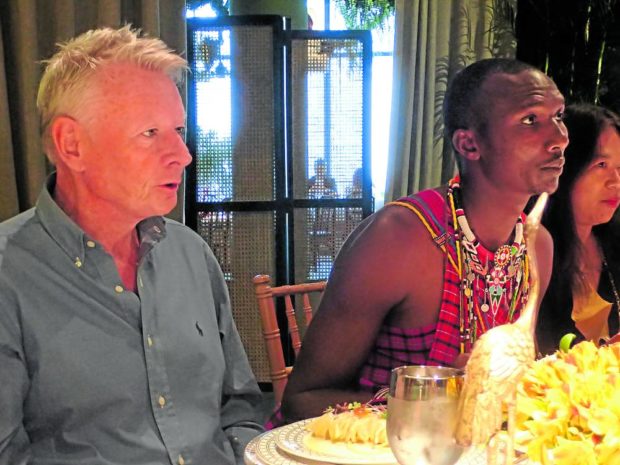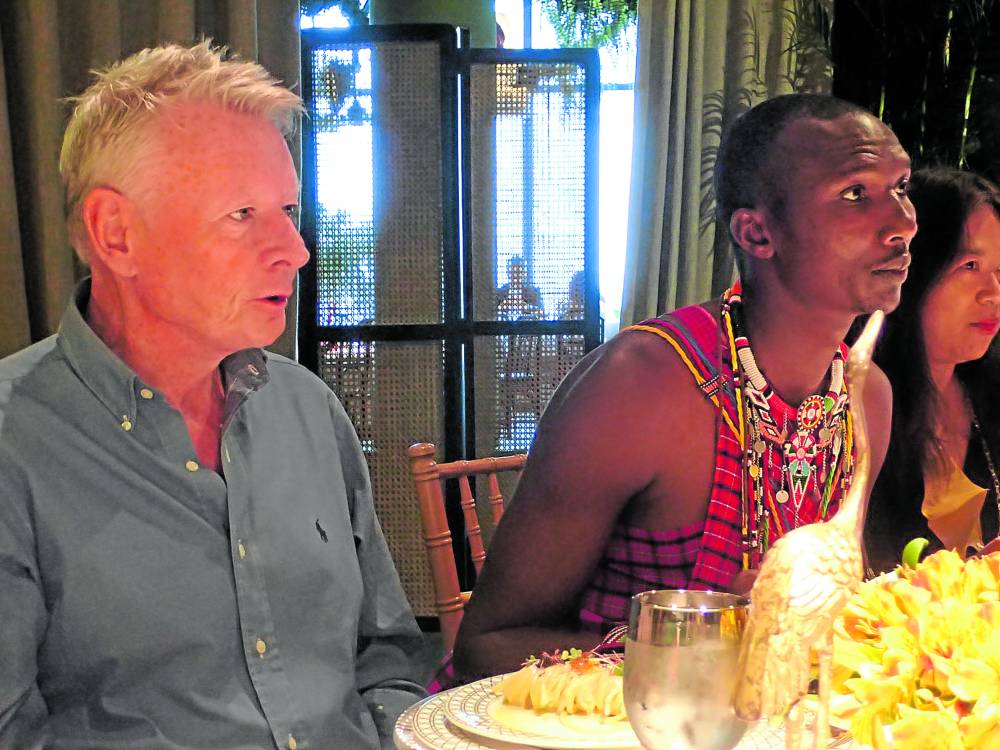It was Godfrey Kinyaga’s first ever flight out of Kenya, and he could hardly believe it.
How was something like a plane able to carry so many people in the air, he wondered. How was he going to “check the tire pressure” (his tribe’s euphemism for men relieving themselves; for the curious, it’s “picking the flowers” for women)? Why was there no beef on the menu?
The towering Maasai warrior only slept one hour while airborne, spending a good chunk of the flight looking out the window despite being a seat away—marveling at the clouds, sky and sea.
He finally landed in Manila after 13 hours and was met with some unfortunate hiccups at immigration. But he wasn’t about to be discouraged. He was on a mission, and it was just the first leg of his Asian roadshow aiming to get an important message across: rhino conservation.
Strikingly clad in a red plaid wrap and an abundance of significant beaded jewelry, Kinyaga recently sat down for an intimate lunch with media at Manila House in Taguig City to talk about just that.
The Maasai is one of around 50 tribes in Kenya, originating from the Upper Nile, but which has since migrated southward. These days, they have settled mostly in Kenya and Tanzania, moving with their livestock, which they use as currency. As cattle people that believe all cows belong to them, they are big red meat eaters—their diet consisting mostly of milk, blood and meat.
Model for conservation
It’s a practice among the famous Maasai warriors to go out and raid cows, sometimes just for praise from their girlfriends. They keep their cattle in an enclosure, protecting them from raiders and attackers, like lions. The fearsome warriors, who act like an army, used to hunt lions as a rite of passage. However, the practice has been banned since 1977 in Kenya, where the warriors now only retaliate against lions suspected of killing livestock.
Kinyaga manages Elewana Kifaru House, a leading safari camp in Kenya, and is a senior safari guide at Lewa Wildlife Conservancy, one of the few remaining strongholds for rhinos in Africa and a pioneer for wildlife conservation.

“Lewa Wildlife Conservancy is a catalyst and a model for conservation,” Kinyaga said. According to him, conservation is deeply ingrained in the mindset of the community in Lewa, so much so that it is taught to them from a very young age.
A2A (Asia to Africa) Safaris, Asia’s first luxury safari specialist, and its longtime partner in Kenya, Cheli & Peacock Safaris, brought Kinyaga to Asia to raise awareness on the alarming rate at which the number of rhinoceroses worldwide has been dwindling. Africa alone has lost over 11,000 rhinos to poaching since 2008, and Asia remains the largest consumer market for rhino horn.
Rhinos are one of the rarer sightings during safari tours, Cheli & Peacock CEO Kieran Day said. Visitors can go their entire stay without seeing neither hide nor hair, nor horn for that matter, of a rhino.
The massive herbivores, second only to elephants in size, can be rather protective and are known to attack humans, supposedly having somehow learned to equate people with poachers. They usually keep to themselves but turn aggressive when threatened. (A word of advice for when one comes a-charging: Stay very, very still.)
However, a friendly rhino is not unheard of, though uncommon. Kinyaga told of a famous rhino roaming Lewa called Elvis who has been known to have formed some attachment to his handler after being mostly hand-raised by humans before being reintroduced to the wild. Years later, the black rhino was able to recognize his handler’s voice and would even come when called.
Status symbol
Rhinos’ horns, which the animals use for foraging and defense, are largely in demand in Asia as traditional Chinese medicine or as status symbol. Rhinos whose horns have been hacked off by poachers usually bleed to death slowly and painfully, or become ill-equipped to fend for themselves.
As a statement of intention by the government, Kenya burned 105 tons of rhino ivory in 1989 to signify the end of poaching. Thankfully, Day said, that commitment has translated to various conservation efforts that are seen today.

He admitted that while it is still possible to help raise the number of rhinos in the wild, the population may never go back to how it used to be due to habitat loss. Such large beasts need large swaths of land to survive, after all.
Nevertheless, collective conservation efforts continue, including Kinyaga’s speaking tour in Manila, Singapore and Bangkok in collaboration with A2A Safaris and Cheli & Peacock Safaris.
Victor Dizon, who founded A2A Safaris in Hong Kong with Jose Cortes 20 years ago, has been strongly engaged in conservation.
“Our love for Africa was developed through our strong passion for conservation, and seeing the ill effects of poaching and climate change on the environment encouraged us to try to promote these destinations more,” said Dizon, who along with his wife, artist Tracie Anglo-Dizon, has gone on countless safari tours. “In a place like Africa, you’ll really understand the magnitude of the problem.”
Admittedly, clients who go on safaris may not even be thinking of conservation. They are usually more focused on ticking items off their list of wild animal sightings, but it paves the way for opening their eyes to the plight of these endangered creatures. Merely going on a safari already provides support for several conservation efforts in the continent. INQ













































